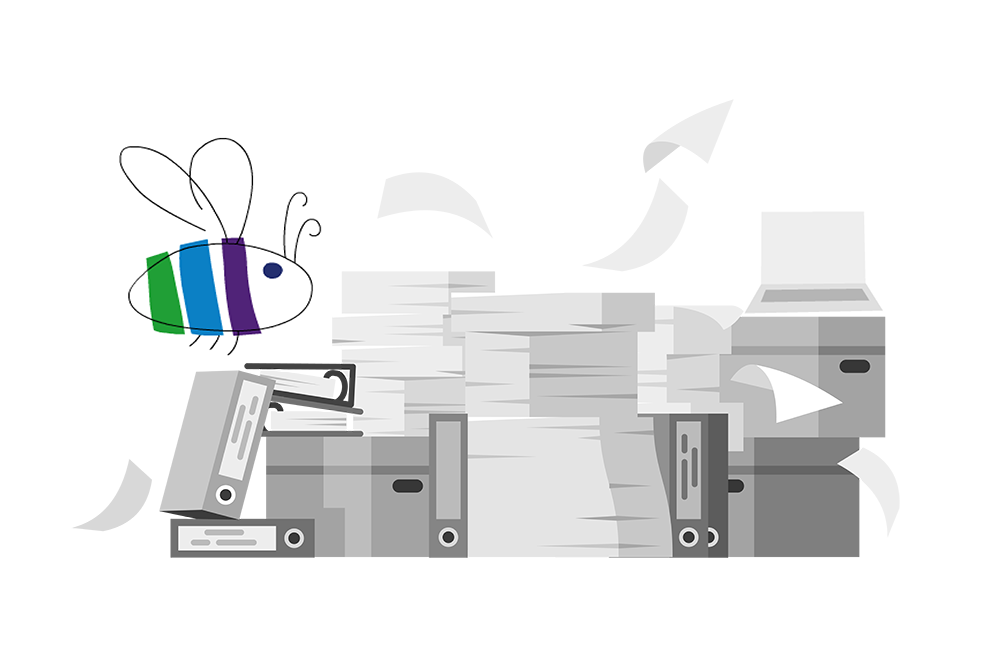
From Content Dump to Curated Journey in eLearning
Let’s be honest, most eLearning starts the same way. Someone sends over a folder full of documents, policies, or slide decks and says:
“Here’s everything we need in the course.”
It’s a familiar story for anyone in learning and development. There’s no shortage of content, but there’s rarely a clear story, purpose, or learner flow.
The result? Information overload. Courses that feel like digital filing cabinets. Learners who click through but don’t connect.
At B Online Learning, we’ve spent over 20 years helping organisations move beyond this content dump to curated journey mindset. The shift isn’t about having less information, it’s about curating content into a guided learning experience that actually teaches, inspires, and sticks.
Why the “Content Dump” Approach Doesn’t Work
The problem with a content dump is simple: it’s about delivery, not design.
When you start with everything and try to cram it all in, your course becomes a mirror of your source material, not a reflection of what learners actually need.
Learners don’t want to read slides. They want to understand, apply, and see relevance.
The irony is that dumping content rarely leads to learning. It often creates confusion, fatigue, or surface-level understanding all because the experience wasn’t designed with intention.
Moving to a curated journey means you take a step back. You stop asking, “What can we include?” and start asking, “What will help them learn?”
What Does It Mean to Curate a Learning Journey?
Curation isn’t about deleting or diluting information. It’s about connecting it.
Think of it like designing an exhibition. You might have hundreds of artefacts, but not everyone goes on display. The curator chooses what best tells the story, arranges pieces to reveal meaning, and builds an experience that flows naturally.
Instructional design works the same way.
A curated learning journey:
- Starts with purpose and outcomes, not source material
- Guides learners step by step toward understanding
- Connects theory to real-world practice
- Builds confidence through relevance and flow
It’s not about information, it’s about experience.
Step 1: Start with Why
Before you open a single file, pause and ask:
- Why does this learning exist?
- What change should it create?
- What do learners need to do differently after completing it?
This simple shift from what’s in the content to why it matters changes everything.
When you understand the purpose, you can filter what belongs in the learning experience and what can stay as reference.
This is where Design Thinking becomes a powerful tool. It helps you empathise with your learners, understand their challenges, and focus on what will truly make a difference.
Read more: Using Design Thinking to Connect with Your Audience
Step 2: Organise, Don’t Overwhelm
Once you know your purpose, you can begin to shape your content.
Start by identifying the core concepts the pieces learners must understand to achieve the goal. Then look at how those ideas relate to one another.
Group similar concepts together. Sequence them logically. Introduce new ideas in manageable steps.
Instructional designers call this process chunking and it’s one of the most effective ways to turn content chaos into clarity.
In practice, it looks like breaking large topics into smaller, purposeful sections each with a clear takeaway or action.
Read more: Break Down Complex Content into Engaging eLearning Experiences
If you’re working with highly technical or layered subject matter, there are even more ways to simplify complexity without losing meaning.
Read more: How to Develop a Successful eLearning Course for Complex Topics
This approach ensures every piece of content has meaning and flow.
Step 3: Write for Humans, Not Documents
Once your content is structured, your words become the learner’s guide.
Too often, eLearning simply lifts language straight from policies or manuals. But those documents weren’t written to teach, they were written to record.
Writing for eLearning is different. It’s about clarity, tone, and accessibility. You’re not just transferring knowledge, you’re building understanding.
That means using plain English, short sentences, and friendly, active voice. Speak directly to the learner. Replace jargon with context.
“What would you do if…” “Here’s how this looks in practice…”
These small shifts make a huge difference in engagement and comprehension.
Read more: Writing for eLearning – Tips and Best Practices
Step 4: Collaborate, Don’t Collect
Subject Matter Experts (SMEs) are vital but only if you treat them as partners, not content suppliers.
Rather than asking, “Can you send me everything you have?”, invite them into the process. Ask questions like:
- What are the biggest mistakes or misconceptions you see?
- What real-world examples bring this to life?
If learners remembered just three things, what should they be?
This transforms your SME from a gatekeeper of information into a co-designer of learning.
Read more: Tips to Work Effectively with Subject Matter Experts
Step 5: Bring It to Life
Once you’ve curated, structured, and written your content, the magic happens in design.
This is where the three pillars of great eLearning come together:
- Instructional – Is the learning clear and purposeful?
- Visual – Is it engaging and easy to navigate?
- Functional – Does it work seamlessly and support participation?
When these pillars align, your course doesn’t just inform, it inspires.
One of our favourite examples of this approach is a project where we transformed dense workplace policies into an engaging, scenario-based learning experience.
Explore next: Starting from Scratch: eLearning Design
It’s proof that when you move from dumping content to designing journeys, even the driest material can come alive.
Step 6: Keep Refining the Flow
Curation is never one-and-done.
After you build, review your learning journey with fresh eyes or better yet, with your learners. Ask:
- Does it make sense in this order?
- Are there points where attention drops?
- What could be simplified or made more visual?
Iterate, refine, and polish. Great design grows through feedback and testing.
The Big Picture
When you curate learning instead of dumping content, everything changes:
- Learners stay engaged because the path is clear.
- Messages stick because they build progressively.
- You spend less time fixing confusion and more time measuring impact.
This shift doesn’t just improve your courses. It transforms your whole approach to design.
It’s the heart of what we teach in our eLearning Design Essentials Workshop, because when you know how to structure, write, and collaborate effectively, every course becomes an opportunity to create real change.
Register for the next workshop and stop dumping, start designing. And watch your content turn into learning that lasts.
Source link



